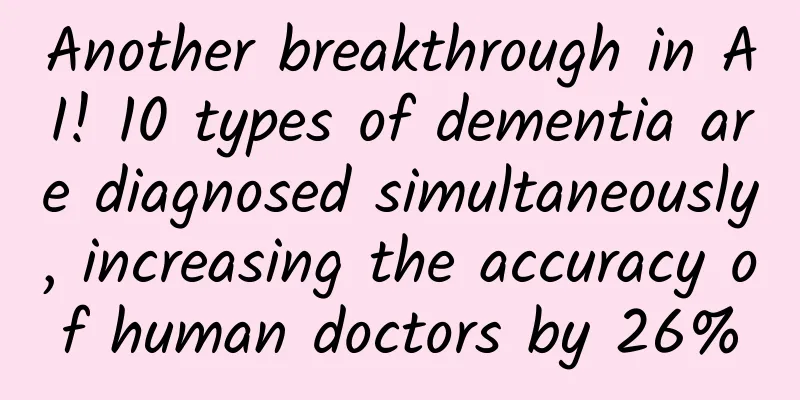Another breakthrough in AI! 10 types of dementia are diagnosed simultaneously, increasing the accuracy of human doctors by 26%

|
Written by | Ma Xuewei Preface Dementia is currently the seventh leading cause of death worldwide and one of the main causes of disability and dependency among older people worldwide. Accurate diagnosis of dementia is beneficial to the health of older people in their later years and reduces the burden on their families. Now, an artificial intelligence (AI) tool developed by a Boston University research team and its collaborators has the potential to help us diagnose 10 different types of dementia (simultaneously), improving neurologists' accuracy by more than 26%. The related research paper, titled "AI-based differential diagnosis of dementia etiologies on multimodal data", has been published online in the scientific journal Nature Medicine. “Our generative AI tool is able to leverage routinely collected clinical data for differential diagnosis of dementia, demonstrating its potential as a scalable diagnostic tool for Alzheimer’s disease and related dementias,” said corresponding author Vijaya B. Kolachalama, PhD, associate professor of medicine at Boston University Chobanian & Avedisian School of Medicine. "There is a shortage of neurology specialists worldwide, while the number of patients who need their help is growing rapidly. This mismatch puts a huge strain on healthcare systems. The research team believes AI can help by identifying these diseases early and assisting doctors to manage patients more effectively, preventing the disease from worsening." The research team hopes that with the number of dementia cases expected to double over the next 20 years, this AI tool can provide accurate differential diagnosis and support the increased need for targeted treatments for dementia. Clinicians’ diagnostic accuracy increased by 26% According to the World Health Organization (WHO), more than 55 million people worldwide currently suffer from dementia, and 10 million new cases of dementia are reported worldwide each year, but different forms of dementia and overlapping symptoms can complicate diagnosis and prevent effective treatment. Therefore, accurate diagnosis of dementia is crucial for developing targeted, personalized management strategies. However, limited access to existing diagnostic tools and a shortage of neurologists and neuropsychologists further exacerbate this challenge. In light of this, the research team developed a multimodal machine learning (ML) framework that uses routinely collected clinical data (such as demographic information, patient- and family-level medical history, medication use, neurological and neuropsychological examination scores, and neuroimaging data such as MRI scans) to accurately identify the specific pathologies that lead to dementia. Figure | Glossary of terms for etiology classification Using multimodal data acquired from a variety of cohorts, the research team's model takes a rigorous approach to differential diagnosis of dementia. It assigns individuals to one or more of thirteen diagnostic categories, which are defined by consensus of a team of neurologists. This pragmatic classification approach is designed to take into account clinical management pathways and thus reflect real-world scenarios. For example, the research team classified Lewy body dementia and Parkinson's disease dementia into the combined category of LBD. This classification is based on the understanding that care for these diseases often follows similar pathways and is often overseen by a multidisciplinary team of movement disorder experts. Figure | Nine independent data sets Nine independent datasets were used in this study, including ADNI, NACC, NIFD, PPMI, OASIS, LBDSU, 4RTNI, and FHS. Data from NACC, NIFD, PPMI, OASIS, LBDSU, and 4RTNI were used for model training. Data from ADNI, FHS, and a holdout set from NACC were used for model testing. In this study, the multimodal ML framework was trained using data from more than 50,000 people from nine different global datasets. Figure | Data, model architecture, and modeling strategy. a, The dementia differential diagnosis model was developed using multiple data modalities, including individual-level demographics, health history, neurological tests, physical/neurological examinations, and multiple sequential MRI scans. These data sources were aggregated from nine independent datasets when available. For model training, the research team merged data from NACC, AIBL, PPMI, NIFD, LBDSU, OASIS, and 4RTNI. The research team used a subset of the NACC dataset for internal testing. For external validation, the research team utilized the ADNI and FHS cohorts. b, Transformer as the architecture of the model. Each feature is processed into a fixed-length vector through a modality-specific embedding (emb.) strategy and provided as input to the transformer. A linear layer is used to connect the transformer with the output prediction layer. c, A subset of the NACC test dataset was randomly selected for comparative analysis to compare the performance of neurologists with and without the assistance of the AI model. Similarly, the research team conducted comparative evaluations with neuroradiologists who were provided with a randomly selected sample of confirmed dementia cases from the NACC test cohort to assess the impact of AI augmentation on their diagnostic performance. In these evaluations, the model and clinicians had access to the same multimodal data. Finally, the research team evaluated the model's predictions by comparing available biomarker profiles and pathology grades from the NACC, ADNI, and FHS cohorts. Figure | Model performance in distinguishing cognitive states The model was able to effectively distinguish between normal cognition, mild cognitive impairment, and dementia, achieving a micro-average AUROC of 0.94, indicating very strong predictive power. The model was consistent across individuals of different ages, genders, and races, indicating good generalization. The model performed well in handling missing data, maintaining reliable predictions even when the data were incomplete. Figure | Model performance in distinguishing causes of dementia The model was able to distinguish 10 different causes of dementia, including Alzheimer's disease, vascular dementia, and Lewy body dementia, achieving a micro-average AUROC of 0.96, indicating high accuracy in etiological diagnosis. The model performed well in dealing with mixed dementia (i.e., multiple causes coexisting), with an average AUROC of 0.78, indicating that it was able to identify complex combinations of causes. The model was consistent with the biomarker test results, and its relationship with different protein diseases was verified by autopsy results, further confirming the reliability and accuracy of the model. Figure | Model performance to improve clinicians’ diagnostic efficiency In 100 randomly selected cases, the AUROC of the AI model-assisted neurologist evaluation was 26.25% higher than that of the neurologist evaluation alone, indicating that the model can improve the accuracy of clinicians in diagnosing dementia. The model prediction results are highly consistent with the evaluation results of neurologists and neuroradiologists, indicating that the model can provide reliable auxiliary diagnostic information. Shortcomings and Prospects The research data mainly comes from white populations and lacks representation of other races and ethnicities. This may cause the model to be biased when dealing with different populations. The dataset contains a large number of AD cases, which may bias the model to identify AD subtypes and ignore the characteristics of other dementia subtypes. Although the model can identify different dementia subtypes, it does not fully account for the heterogeneity of AD pathology. Future studies are needed to more deeply analyze the characteristics of different AD subtypes and evaluate the performance of the model on these subtypes. The model combined mild, moderate, and severe dementia into one category, which may not fully reflect the nuanced assessment of disease stage in specific medical settings. Future studies could consider including disease stage as an additional dimension to improve the accuracy of the model. The model training data may reflect the subjectivity and variability of diagnostic decisions between different clinicians, which may affect the accuracy of the model. Future studies need to collect more consistent and standardized diagnostic data to further improve the reliability of the model. In the future, the research team said that they can try to collect more patient data from different races and ethnicities and different clinical settings to improve the generalization ability of the model; by improving the model architecture, develop models that can better handle the heterogeneity of AD pathology, such as combining more complex neural network structures or more sophisticated feature extraction methods; combine AI models with other technologies, such as electroencephalograms, genetic testing, etc., to obtain more comprehensive patient information and further improve the accuracy of diagnosis; in addition, long-term follow-up studies can be conducted to track patients' disease progression and treatment effects, evaluate the predictive ability of the model, and verify its value in clinical practice. Paper link: https://www.eurekalert.org/news-releases/1050605 https://www.nature.com/articles/s41591-024-03118-z https://www.who.int/en/news-room/fact-sheets/detail/dementia |
>>: Without dieting or exercising, what other scientific ways are there to lose weight?
Recommend
There is a strange smell after the period
If a woman has an odor after her menstrual period...
Black blood half a month early
At present, many women have a confusing problem, ...
What are the causes of abdominal pain in early pregnancy
Many women experience abdominal pain during pregn...
Is it normal for milk not to increase after weaning?
Weaning is a problem that every breastfeeding wom...
What to do if you have gastritis during pregnancy
Many female friends suffer from chronic gastritis...
Do I need an injection for pelvic inflammatory disease?
Pelvic inflammatory disease is not a serious dise...
Harris Interactive: Mobile shopping users are interested in SMS marketing
The maturity of the mobile phone market has given...
Can I exercise when my period comes?
After your period comes, you should pay more atte...
What causes cysts in the uterus?
Many female friends cannot conceive for a long ti...
Treatment of cervical cysts
Although cervical cysts are not very difficult to...
Pain three fingers below the navel in women
For female friends, if there is pain in the uteru...
Which moles on a woman's face should be removed?
Almost everyone has moles on their bodies, the ke...
Can you detect cancer by drawing blood? Is the popular tumor marker screening in physical examinations really useful?
Screening for cancer using "tumor markers&qu...
Tips for pregnant women to prevent freckles
Pregnant women should do a good job of preventing...
How many weeks does a pregnant woman stop taking calcium tablets?
Women will experience leg cramps after becoming p...









![[Creative Cultivation Program] Is chapped skin in winter really caused by freezing?](/upload/images/67f1c17521590.webp)